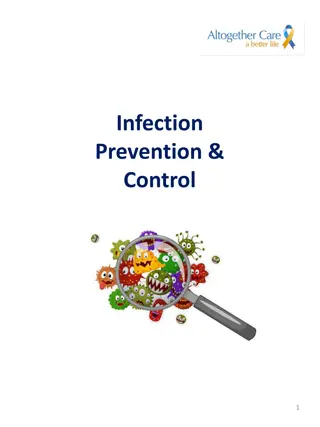Understanding Host Defense Mechanisms Against Infection
Host defense mechanisms safeguard the body from pathogens through various strategies such as intact skin, mucous membranes, nonspecific immune responses like phagocytic cells, and specific immune responses involving antibodies and lymphocytes. Key protective barriers include the skin, eyes, digestive tract, genitourinary tract, and respiratory tract. These barriers utilize mechanisms like lysozymes, mucus production, acidic environments, and microbial antagonism to prevent pathogen entry and colonization.
Download Presentation

Please find below an Image/Link to download the presentation.
The content on the website is provided AS IS for your information and personal use only. It may not be sold, licensed, or shared on other websites without obtaining consent from the author. Download presentation by click this link. If you encounter any issues during the download, it is possible that the publisher has removed the file from their server.
E N D
Presentation Transcript
Host defenses that protect against infection include. (eg, skin, mucous membranes) Nonspecific immune responses (eg, phagocytic cells [neutrophils, macrophages] and their products). Defenses against any pathogen Specific immune responses (eg, antibodies, lymphocytes) Resistance to a specific pathogen
Intact, unbroken skin (Broken skin = port of entry) Almost all bacteria are incapable to penetrate. skin predominantly inhabited by Staphylococcus epidermidis How? Dryness temperature Low pH (acidic) of skin; bacteriocidal secretion by the sebaceous glands Desquamation sloughing of epithelium Perspiration (sweat contain lysozymes attack bacterial cell wall) Exception: Staphylococcus aureus in moist area
Eyes Blinking of eyelids Tears containing lysozymes Outer ear canal Wax contains antibacterial components Mucus membranes layers of mucosal cells that line body (digestive, genitourinary and respiratory tracts) Mucus is produced by the mucosal cells Contains antimicrobial substance such as lysozymes, lactoferrin Mucosal cells are rapidly dividing flush out of body along with attached bacteria
Digestive tract Mouth and lower digestive tract lots of How? Mucus Saliva (contains lysozyme) Bile (alkaline) in small intestine Stomach acids Defecation (feces contains up to 50% bacteria !) Mucus contain antibacterial agents, antibodies and immune cells called phagocytes
Genitourinary tract Urinary tract is sterile in a health person except the distal urethra How? Urination Secretion (vaginal and seminal fluid) Low pH of vagina (presence of several Lactobacillus sp., Candida albicans
Respiratory tract Nose - nasal hair, mucus secretions (phagocytes and antibacterial enzymes). ciliated epithelium (nasal cavity, sinuses, bronchi and trachea) Cough reflexes Alveolar macrophages Microbial antagonism Normal human microbiota. invaders Compete for colonization sites Compete for nutrients Produce bacteriocins
Once beyond the protective outer barrier of the body, the invading microbes will encounter a series of nonspecific cellular and chemical defense mechanisms Mechanisms: Inflammation a series of events that removes the offending agent and repair the damage Chemotaxis movement of cells toward a chemical influence (chemokines or chemotatic agents) Phagocytosis process in which cell ingest foreign particulate matter e.g. microbes Many are carried out by the white blood cells in blood
Erthrocytes (RBC) Platelets Wright s stain of the peripheral blood cells can identify granulocytes based on properties of the granules. It contain two dyes: Eosin dye stains basic cell components reddish Methylene blue dye stain acidic cell components blue-ish
Acute phase proteins set of plasma proteins whose level increases during infection to enhance host defense mechanisms e.g. complement proteins, coagulating factors, transferrins Cytokines small secreted proteins produced by cells Communication between different defense systems Examples: interleukins, interferons
Fever Pyrogens are substances that stimulate fever External, e.g. bacterial endotoxin Internal (endogenous), e.g. interleukins (IL-1) Body temperature increases in response to pyrogens to: Stimulate WBC to deploy & destroy microbes increase in immunological response (e.g. proliferation and activation of lymphocytes) Slow down growth of or kill pathogens Interferons Anti-viral proteins produced by virus-infected cells (eventually died).
The complement systems Consists of ~30 proteins that complement the action of the immune system Functions: Inflammation Stimulate leukocytes Lyse bacteria Increase phagocytosis by opsonization
Four cardinal signs Redness Heat Swelling Pain Major events Vasodilation Increase permeability of capillaries Mobilization of leukocytes to site of injury (chemotaxis & emigration) Phagocytosis Primary functions Localize infection Neutralize toxins at injury site Repair damage tissue
Phagocytosis Phagocytosis is the ingestion of microorganisms or other matter by a cell. Many white blood cells engulf invasive microorganisms by the process of phagocytosis. The steps in phagocytosis are:























